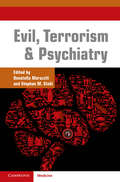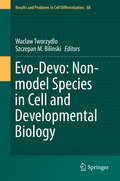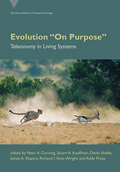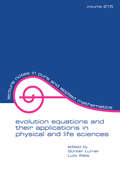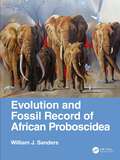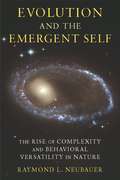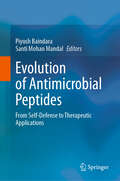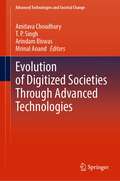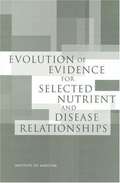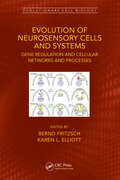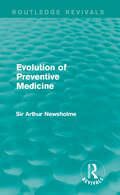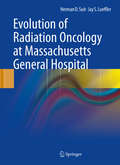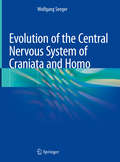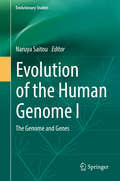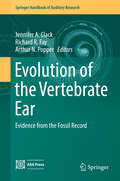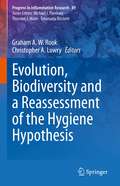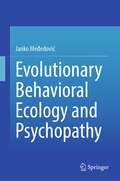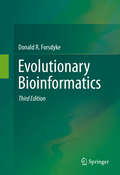- Table View
- List View
Evidenzbasiertes perioperatives Management in der Viszeralchirurgie: Leitlinien, Empfehlungen und Studienlage (Evidenzbasierte Chirurgie)
by E. Sebastian Debus Reinhart T. GrundmannDas Buch bildet die Basis für eine evidenzbasierte perioperative Behandlung bei allen häufigen viszeralchirurgischen Operationen. Die einzelnen Maßnahmen (wie Ernährung, Analgesie, perioperative Antibiotikaprophylaxe und Hämotherapie) werden auf der Grundlage der weltweit publizierten Empfehlungen bewertet. Berücksichtigt sind die nationalen und internationalen Leitlinien, die Ergebnisse von Metaanalysen, Cochrane-Reviews und anderen randomisierten Studien sowie weitere verfügbare Informationen, die nicht in den Leitlinien stehen. Differenzierte, gut begründete Vorschläge ermöglichen ein patientengerechtes und wissenschaftlich fundiertes perioperatives Management in der Klinik. Ganz aktuell: ein Kapitel zum perioperativen Management bei COVID-19-Patienten!
Evil, Terrorism and Psychiatry: Stahl Essential Psychopharmacology Handbooks
by Stephen M. Stahl Donatella MarazzitiTerrorism has dominated the domestic and international landscape since 9/11. Determining what drives people to commit acts of terrorism is no easy task. The important new book fills a gap in the psychology and psychiatry literature by examining the relationship between evil and mental illness, and in particular amongst terrorists. How can evil, a characteristic of human nature, become extreme, intent on destruction and lead to acts of terrorism? Featuring contributions from leading experts in this field, Evil, Terrorism and Psychiatry explores whether there are specific personality traits, psychological characteristics or psychopathological conditions that may favour a lack of control of violence in terrorists. It also offers possible novel prevention strategies to help understand and prevent these acts in future. Featuring articles from a special issue of CNS Spectrums, this book also includes brand new chapters found exclusively in this book.
Evo-Devo: Non-model Species in Cell and Developmental Biology (Results and Problems in Cell Differentiation #68)
by Waclaw Tworzydlo Szczepan M. BilinskiEvolutionary developmental biology or evo-devo is a field of biological research that compares the underlying mechanisms of developmental processes in different organisms to infer the ancestral condition of these processes and elucidate how they have evolved. It addresses questions about the developmental bases of evolutionary changes and evolution of developmental processes. The book’s content is divided into three parts, the first of which discusses the theoretical background of evo-devo. The second part highlights new and emerging model organisms in the evo-devo field, while the third and last part explores the evo-devo approach in a broad comparative context. To the best of our knowledge, no other book combines these three evo-devo aspects: theoretical considerations, a comprehensive list of emerging model species, and comparative analyses of developmental processes. Given its scope, the book will offer readers a new perspective on the natural diversity of processes at work in cells and during the development of various animal groups, and expand the horizons of seasoned and young researchers alike.
Evolution "On Purpose": Teleonomy in Living Systems (Vienna Series in Theoretical Biology)
by Peter A. Corning, et al.A unique exploration of teleonomy—also known as &“evolved purposiveness&”—as a major influence in evolution by a broad range of specialists in biology and the philosophy of science.The evolved purposiveness of living systems, termed &“teleonomy&” by chronobiologist Colin Pittendrigh, has been both a major outcome and causal factor in the history of life on Earth. Many theorists have appreciated this over the years, going back to Lamarck and even Darwin in the nineteenth century. In the mid-twentieth century, however, the complex, dynamic process of evolution was simplified into the one-way, bottom-up, single gene-centered paradigm widely known as the modern synthesis. In Evolution &“On Purpose,&” edited by Peter A. Corning, Stuart A. Kauffman, Denis Noble, James A. Shapiro, Richard I. Vane-Wright, and Addy Pross, some twenty theorists attempt to modify this reductive approach by exploring in depth the different ways in which living systems have themselves shaped the course of evolution.Evolution &“On Purpose&” puts forward a more inclusive theoretical synthesis that goes far beyond the underlying principles and assumptions of the modern synthesis to accommodate work since the 1950s in molecular genetics, developmental biology, epigenetic inheritance, genomics, multilevel selection, niche construction, physiology, behavior, biosemiotics, chemical reaction theory, and other fields. In the view of the authors, active biological processes are responsible for the direction and the rate of evolution. Essays in this collection grapple with topics from the two-way &“read-write&” genome to cognition and decision-making in plants to the niche-construction activities of many organisms to the self-making evolution of humankind. As this collection compellingly shows, and as bacterial geneticist James Shapiro emphasizes, &“The capacity of living organisms to alter their own heredity is undeniable.&”
Evolution Equations and Their Applications in Physical and Life Sciences: Proceedings Of The Bad Herrenalb (karlsruhe), Germany, Conference (Lecture Notes in Pure and Applied Mathematics)
by G LumerThis volume presents a collection of lectures on linear partial differntial equations and semigroups, nonlinear equations, stochastic evolutionary processes, and evolution problems from physics, engineering and mathematical biology. The contributions come from the 6th International Conference on Evolution Equations and Their Applications in Physica
Evolution and Fossil Record of African Proboscidea
by William J. SandersThis book details the long, diverse, and complex phylogenetic history of elephants and their fossil relatives (the Proboscidea), whose origin is deeply embedded some 60 million years ago in Africa. Most of the major evolutionary events of proboscideans occurred in Africa, and these are examined in their geological, paleoecological, geographic, and faunal contexts. Updated information about feeding adaptations, taxonomy and systematics, genetics, and site occurrences is included and summarized in tables, figures, and charts. This is the first comprehensive review of African proboscideans and illustrates the need to more actively protect elephants and ensure their survival in modern ecosystems. Key Features: Provides a comprehensive systematic review of the African proboscidean fossil record Includes a summary of taxonomy, geochronology, biogeography and morphology Documents major faunal events including those associated with hominin origins Synthesizes new data from genomic, isotopic, and microware analyses Emphasizes the role of elephants in ecosystems and the importance of conservation
Evolution and the Emergent Self: The Rise of Complexity and Behavioral Versatility in Nature
by Raymond NeubauerEvolution and the Emergent Self is an eloquent and evocative new synthesis that explores how the human species emerged from the cosmic dust. Lucidly presenting ideas about the rise of complexity in our genetic, neuronal, ecological, and ultimately cosmological settings, the author takes readers on a provocative tour of modern science's quest to understand our place in nature and in our universe. Readers fascinated with "Big History" and drawn to examine big ideas will be challenged and enthralled by Raymond L. Neubauer's ambitious narrative.How did humans emerge from the cosmos and the pre-biotic Earth, and what mechanisms of biological, chemical, and physical sciences drove this increasingly complex process? Neubauer presents a view of nature that describes the rising complexity of life in terms of increasing information content, first in genes and then in brains. The evolution of the nervous system expanded the capacity of organisms to store information, making learning possible. In key chapters, the author portrays four species with high brain:body ratios—chimpanzees, elephants, ravens, and dolphins—showing how each species shares with humans the capacity for complex communication, elaborate social relationships, flexible behavior, tool use, and powers of abstraction. A large brain can have a hierarchical arrangement of circuits that facilitates higher levels of abstraction.Neubauer describes this constellation of qualities as an emergent self, arguing that self-awareness is nascent in several species besides humans and that potential human characteristics are embedded in the evolutionary process and have emerged repeatedly in a variety of lineages on our planet. He ultimately demonstrates that human culture is not a unique offshoot of a language-specialized primate, but an analogue of fundamental mechanisms that organisms have used since the beginning of life on Earth to gather and process information in order to buffer themselves from fluctuations in the environment.Neubauer also views these developments in a cosmic setting, detailing open thermodynamic systems that grow more complex as the energy flowing through them increases. Similar processes of increasing complexity can be found in the "self-organizing" structures of both living and nonliving forms. Recent evidence from astronomy indicates that planet formation may be nearly as frequent as star formation. Since life makes use of the elements commonly seeded into space by burning and expiring stars, it is reasonable to speculate that the evolution of life and intelligence that happened on our planet may be found across the universe.
Evolution of Antimicrobial Peptides: From Self-Defense to Therapeutic Applications
by Piyush Baindara Santi Mohan MandalOver the last century, antibiotics have been a primary treatment for infectious diseases, and indiscriminate use by both healthcare providers and patients has led to the rapid emergence of resistant pathogens. Multidrug-resistant pathogens and infective agents are an urgent threat to global health, and this issue has created a critical need for the investigation of alternatives to conventional antibiotics. Antimicrobial peptides (AMPs) have emerged as promising alternative therapeutics, with studies on their mechanisms and applications an area of intense interest in agricultural science, physiology, and medicine. AMPS are naturally occurring components of the host defense system, and functional throughout all orders of life, from prokaryotes to eukaryotes. They are potent molecules with broad spectrum activities against infectious agents, including bacteria, fungi, viruses, and parasites. AMPs have demonstrated therapeutic potential against non-infectious diseases like chronic inflammation and cancer, and have been found to have potential activities against slow-growing bacteria, such as biofilms. This book summarizes the current available research on AMPs, including discovery, screening, and characterization, for therapeutic applications. It discusses molecular biology, proteomics, genomics, and bioinformatics approaches. In addition, it covers AMP classification and evolutionary studies, from prokaryotes to eukaryotes.
Evolution of Atopic Dermatitis in the 21st Century
by Ichiro Katayama Hiroyuki Murota Takahiro SatohThis comprehensive guide offers a state-of-the-art overview of basic and clinical aspects of atopic dermatitis (AD). The name "atopic dermatitis" was first used in 1933, and Drs. Lewis Webb Hill and Marion B. Sulzberger presented their report "Evolution of atopic dermatitis" in 1935. Their observations accurately forecasted the contemporary issues in the management of the condition, such as the conclusions that should be drawn from our understanding of the pathogenesis of AD, and the use of steroids as the main treatment. Several aggravating factors have recently been identified, and these also need to be addressed. In this context, the expert contributors to this book describe and discuss the evolution of atopic dermatology from Sulzberger's era to the present day, including clinical manifestations, etiopathology and treatment. In addition, it explores skin care intervention, the role of microbiom and GWAS studies, and presents unique, previously unpublished cohort studies. It provides insights into the dynamic changes in AD since Sulzberger introduced topical steroids for its treatment. It is a valuable resource for dermatologists, medical practitioners and researchers who are interested in atopic dermatology.
Evolution of Cardio-Metabolic Risk from Birth to Middle Age
by Gerald S. BerensonThat precursors of adult coronary artery disease, hypertension, and type II diabetes begin in childhood have been clearly established by the Bogalusa Heart Study. This unique research program has been able to follow a biracial (black/white) population over 35 years from childhood through mid-adulthood to provide perspectives on the natural history of adult heart diseases. Not only do these observations describe trajectories of cardio-metabolic risk variables leading to these diseases but provide a rationale for the need to begin prevention beginning in childhood. The trajectories of the burden of cardio-metabolic risk variables in the context of their fetal origin and chromosome telomere dynamics provide some insight into the metabolic imprinting in utero and aging process. The observed racial contrasts on cardio-metabolic risk variables implicate various biologic pathways interacting with environment contributing to the high morbidity and mortality from related diseases in our population. To address the seriousness of the onset of cardiovascular disease in youth, approaches to primordial prevention are described focussing on childhood health education as an important aspect of Preventive Cardiology.
Evolution of Digitized Societies Through Advanced Technologies (Advanced Technologies and Societal Change)
by Arindam Biswas T. P. Singh Amitava Choudhury Mrinal AnandThis book provides an understanding of the evolution of digitization in our day to day life and how it has become a part of our social system. The obvious challenges faced during this process and how these challenges were overcome have been discussed. The discussions revolve around the solutions to these challenges by leveraging the use of various advanced technologies. The book mainly covers the use of these technologies in variety of areas such as smart cities, healthcare informatics, transportation automation, digital transformation of education. The book intends to be treated as a source to provide the systematic discussion to the bouquet of areas that are essential part of digitized societies. In light of this, the book accommodates theoretical, methodological, well-established, and validated empirical work dealing with various related topics.
Evolution of Evidence for Selected Nutrient and Disease Relationships
by Committee on Examination of the Evolving Science for Dietary SupplementsInformation on the Evolution of Evidence for Selected Nutrient and Disease Relationships
Evolution of Machine Learning and Internet of Things Applications in Biomedical Engineering (Emerging Trends in Biomedical Technologies and Health informatics)
by Arun Kumar Rana Vishnu Sharma Sanjeev Kumar Rana Vijay Shanker ChaudharyThis book provides a platform for presenting machine learning (ML)-enabled healthcare techniques and offers a mathematical and conceptual background of the latest technology. It describes ML techniques along with the emerging platform of the Internet of Medical Things used by practitioners and researchers around the world.Evolution of Machine Learning and Internet of Things Applications in Biomedical Engineering discusses the Internet of Things (IoT) and ML devices that are deployed for enabling patient health tracking, various emergency issues, and the smart administration of patients. It looks at the problems of cardiac analysis in e-healthcare, explores the employment of smart devices aimed at different patient issues, and examines the usage of Arduino kits where the data can be transferred to the cloud for Internet-based uses. The book includes deep feedforward networks, regularization, optimization algorithms, convolutional networks, sequence modeling, and practical methodology. The authors also examine the role of IoT and ML in electroencephalography and magnetic resonance imaging, which play significant roles in biomedical applications. This book also incorporates the use of IoT and ML applications for smart wheelchairs, telemedicine, GPS positioning of heart patients, and smart administration with drug tracking. Finally, the book also presents the application of these technologies in the development of advanced healthcare frameworks.This book will be beneficial for new researchers and practitioners working in the biomedical and healthcare fields. It will also be suitable for a wide range of readers who may not be scientists but who are also interested in the practices of medical image retrieval and brain image segmentation.
Evolution of Neurosensory Cells and Systems: Gene regulation and cellular networks and processes (Evolutionary Cell Biology)
by Bernd FritzschThis book is an overview of primary sensory maps of vertebrates, characterized by continuous and discrete properties. The eight primary sensory maps of vertebrates have unique features and use distinct molecular cues, cell cycle exit, and activity combinations during development, regeneration, and plasticity. As an introduction and overview, the book provides a short overview for all eight sensory senses and presents through evolution and gene regulatory networks, the molecular cues needed for sensory processing. Independent contributions are included for olfactory, vision, trigeminal, taste, vestibular, auditory, lateral line, and electroreception.
Evolution of Preventive Medicine: Being A Continuation Of The Evolution Of Preventive Medicine (Routledge Revivals)
by Sir Arthur NewsholmeFirst published in 1927, this book provides a complete study of the beginnings and early development of preventive medicine. It looks at the subject’s underlying principles and discusses the prominent writers of the past. Topics cover infection, plague, science and medicine, poverty and preventive medicine and the prevention of cholera, amongst others.
Evolution of Radiation Oncology at Massachusetts General Hospital
by Jay S. Loeffler Herman D. SuitThe Massachusetts General Hospital (MGH) has a history of excellence and is internationally recognized as a world class medical center, providing quality medical care, advancing medicine through clinical and laboratory research and facilitating the education of exceptional health care professionals. The Massachusetts General Hospital Radiation Oncology Department, staff, residents and fellows, past and present, concur that MGH stands for Man's Greatest Hospital. This decidedly immodest assessment is widely viewed amongst this group as being manifestly true, and that perception is clearly reflected in a marvelous esprit de corp. Such an unequivocally positive attitude is solidly based on the judgment that the best possible care is provided to each MGH patient, i.e. the patient is, in fact, Number One. There is a deep sense of pride in the contributions made by this department to the scientific advancement of oncology, and to progressively and substantially increasing the proportion of patients who are free of tumor and of treatment related morbidity. Evolution of Radiation of Oncology at Massachusetts General Hospital is the work of the former Chair of the Department, Herman D. Suit. From 1970 - 2000, his guidance and management of this Department brought it to recognition as a world class center. Dr. Suit was key in the development and building of the Department that now includes The Northeast Proton Therapy Center at the MGH. His passion for the science of radiation therapy and its evolving growth through the years is evident in this book. He has assembled a fascinating chronicle, beginning with the creation of MGH in 1811 followed by personal experiences that culminated with his leadership of the Radiation Oncology Department.
Evolution of Visual and Non-visual Pigments
by N. Justin Marshall David M. Hunt Mark W. Hankins Shaun P CollinPhotopigments are molecules that react to light and mediate a number of processes and behaviours in animals. Visual pigments housed within the photoreceptors of the eye, such as the rods and cones in vertebrates are the best known, however, visual pigments are increasingly being found in other tissues, including other retinal cells, the skin and the brain. Other closely related molecules from the G protein family, such as melanopsin mediate light driven processes including circadian rhythmicity and pupil constriction. This Volume examines the enormous diversity of visual pigments and traces the evolution of these G protein coupled receptors in both invertebrates and vertebrates in the context of the visual and non-visual demands dictated by a species' ecological niche.
Evolution of the Central Nervous System of Craniata and Homo
by Wolfgang SeegerThe main focus of this book is on providing students, neurosurgery trainees, certified neurosurgeons and colleagues in neighbouring disciplines essential information on the evolution of the central nervous system (CNS) of craniata and homo. Therefore the book is divided in three parts: Part I is describing the evolution of CNS of craniata (starting 800 million of years ago). Part II is explaining in detail the exceptional position of the human encephalon. Part III is discussing maturity and immaturity of all parts of CNS of craniatas and the consequences concerning further development of brain structure and psychological functions. In all parts anatomical fundamentals are presented in the form of didactic and self-explanatory illustrations.
Evolution of the Human Genome I
by Naruya SaitouThis book reviews the human genome from an evolutionary perspective. No such book has ever been published before, although there are many books on human genomes. There are two parts in this book: Overview of the Human Genome (Part I) and The Human Genome Viewed through Genes (Part II). In Part I, after a brief review of human evolution and the human genome (by Naruya Saitou), chapters on rubbish or junk DNA (by Dan Graur), GC content heterogeneity (by Satoshi Oota), protein coding and RNA coding genes (by Tadashi Imanishi), duplicated genes (by Takashi Kitano), recombinations (by Montanucci and Bertranpetit), and copy number variations including microsatellites (by Naoko Takezaki) are discussed. Readers can obtain various new insights on the human genome from this part. In Part II, genes in X and Y chromosomes (by Yoko Satta and others), HLA genes (by Timothy A. Jinam), opsin genes (by Shoji Kawamura and Amanda D. Melin), genes related to phenotypic variations (by Ryosuke Kimura), transcription factors (by Mahoko Takahashi and So Nakagawa), diabetes-related genes (by Ituro Inoue), disease genes in general (by Ituro Inoue and Hirofumi Nakaoka), and microbial genomes (by Chaochun Wei) are discussed. The human genome sequences were determined in 2004, and after more than 10 years we are now beginning to understand the human genome from an evolutionary point of view. This book furnishes readers with a good summary of current research in the field.
Evolution of the Human Genome II: Human Evolution Viewed from Genomes (Evolutionary Studies)
by Naruya SaitouThis two-volume set provides a general overview of the evolution of the human genome; The first volume overviews the human genome with descriptions of important gene groups. This second volume provides up-to-date, concise yet ample knowledge on the genome evolution of modern humans. It comprises twelve chapters divided into two parts discussing “Non-neutral Evolution on Human Genes” (Part I) and “Evolution of Modern Human Populations” (Part II.) The most significant feature of this book is the continent-wise discussion of modern human dispersal using human genomic data in Part II. Recent results such as introgression of paleogenomes to modern humans, new methods such as computer simulation of global human dispersals, and new information on genes for humanness will be of particular interest to the readers. Since the euchromatin regions of the human genome was sequenced in 2003, a huge number of research papers were published on modern human evolution for a variety of populations. It is now time to summarize these achievements. This book stands out as the most comprehensive book on the modern human evolution, focusing on genomic points of view with a broad scope. Primary target audiences are researchers and graduate students in evolutionary biology.
Evolution of the Vertebrate Ear
by Jennifer A. Clack Arthur N. Popper Richard R FayThe evolution of vertebrate hearing is of considerable interest in the hearing community. However, there has never been a volume that has focused on the paleontological evidence for the evolution of hearing and the ear, especially from the perspective of some of the leading paleontologists and evolutionary biologists in the world. Thus, this volume is totally unique, and takes a perspective that has never been taken before. It brings to the fore some of the most recent discoveries among fossil taxa, which have demonstrated the sort of detailed information that can be derived from the fossil record, illuminating the evolutionary pathways this sensory system has taken and the diversity it had achieved.
Evolution, Biodiversity and a Reassessment of the Hygiene Hypothesis (Progress in Inflammation Research #89)
by Graham A. W. Rook Christopher A. LowryThis edited collection of 12 chapters by research workers from a wide range of disciplines resolves the confusion that currently surrounds the “hygiene hypothesis” by considering the human need for exposure to microorganisms from an evolutionary point of view. The book explains why we evolved a requirement for exposure to microbiota from our mothers, from other people, and from the natural environment. It also explains the physiological roles of these exposures, what goes wrong when the exposures are distorted and how human lifestyles and activities, including degradation of the natural environment, are leading to this distortion. Particular attention is given to the range of pathologies associated with inappropriate microbial exposures and inappropriate colonization, including immunoregulatory problems such as allergies and autoimmunity, metabolic problems such as obesity and diabetes, and problems of central nervous system function and neurodegeneration. This book is of profound relevance to most medical disciplines, but also to those concerned with preserving the natural environment and with developing healthier urbanisation.
Evolution-adjusted Tumor Pathophysiology: The Novel Language of Tumor Biology
by Albrecht ReichleCombined modularized therapies for metastatic cancer are pointing to central problems of communication among 'systems participators'. A communication theory explains 'social engineering', endogenously induced or by implementing non-normative boundary conditions. Evolution-adjusted tumor pathophysiology is borne by an evolution theory, which contrasts narrative evolution histories. The tool of rationalizations constituting the tumor's normativity (inflammation, immune response etc.) represents the non-genomic counterpart of the tumor genome and should be additionally assessed during tumor staging. Evolution-adjusted tumor pathophysiology allows implementing applied systems biology, a novel clinical and pharmaceutical technology for bioengineering tumor response and personalizing tumor therapy. Combined modularized therapy, evolution-adjusted tumor pathophysiology, and 'universal' biomarkers concertedly address genetically based tumor heterogeneity.
Evolutionary Behavioral Ecology and Psychopathy
by Janko MeđedovićThis book examines the study of psychopathy using behavioral ecological framework. It consists of two parts. The first describes the science of human behavioral ecology, including:• Basic concepts of evolutionary biology• Evolutionary behavioral sciences• Evolutionary ecology of family• Evolutionary tradeoffs• Life history theory• Behavioral ecology of personality• Psychopathy and its current evolution.The second part of the book describes empirical research on psychopathy in evolutionary ecological context, aiming to explore fertility-longevity tradeoffs in psychopathy, interacting phenotypes in psychopathy, and parental effects associated with psychopathy. This part contains the discussion of the study’s findings which is based on several theoretical concepts described in part one. This volume is ideal for psychopathy researchers hoping to bridge the natural and social sciences in a new and innovative way.
Evolutionary Bioinformatics
by Donald R. ForsdykeNow in its third edition and supplemented with more online material, this book aims to make the "new" information-based (rather than gene-based) bioinformatics intelligible both to the "bio" people and the "info" people. Books on bioinformatics have traditionally served gene-hunters, and biologists who wish to construct family trees showing tidy lines of descent. While dealing extensively with the exciting topics of gene discovery and database-searching, such books have hardly considered genomes as information channels through which multiple forms and levels of information have passed through the generations. This "new bioinformatics" contrasts with the "old" gene-based bioinformatics that so preoccupies previous texts. Forms of information that we are familiar with (mental, textual) are related to forms with which we are less familiar (hereditary). The book extends a line of evolutionary thought that leads from the nineteenth century (Darwin, Butler, Romanes, Bateson), through the twentieth (Goldschmidt, White), and into the twenty first (the final works of the late Stephen Jay Gould). Long an area of controversy, diverging views may now be reconciled.

